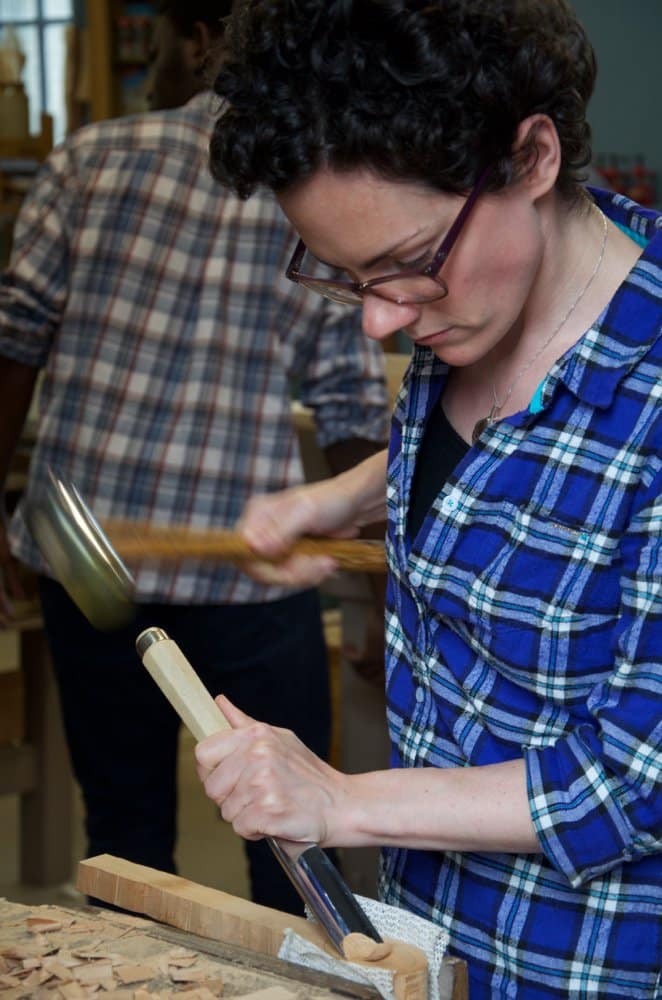Working wood makes a good living…

In some ways my blog records a wide range of things I might otherwise have never written down and that includes everything from new tool reviews to my opinions on sharpness and what sharpness is. Some time back I presented something to my students suggesting the question of why we sharpen to 15,000 grit when we can barely if at all discern the difference when we plane the wood to say 400 grit. I did the same thing today as I do occasionally and sharpened two planes in front of them. They watched the shavings emerge from the two planes with ease and were astounded that there was so little discernible difference both in effort and result. To some this is heresy but the proof of the pudding for me came when i started to question why sharpen to such tight tolerances when the result are not clearly and visibly different. 

Someone came through last week and yet again reminded me that no one can make a living from woodworking these days. I know that that’s not the case but of course what he was saying really is that no one can make money from woodworking these days. That’s a whole different thing. Making money is exchanging what you make for an amount of money you can exchange for a lifestyle you want beyond woodworking or other than woodworking. Making a living is living woodworking and doing it even if you must work differently than other people do. If I needed or to work longer or be better at designing my work to live woodworking then that is what I did or would do. it’s simple enough. Working is not an unpleasant thing for me and that is why at 65 I still put in around 10-12 hours in a given day. 



I could tell that you lined up the planes on the bench for specific purposes, but was not sure of those purposes or the differences between the planes. Thank you for the explanation.
I listened to my parents. My mother told me to be the best at whatever I do. My father told me to “be a boss.” They both wanted me to be a doctor. I listened and believed.
I was wrong. I sat behind a desk or in a cubical, got two Masters degrees that the faculty somehow derisively called “terminal degrees” because they didn’t lead to a PhD. I sat in front of a computer screen and my physical and emotional health went to hell in a handbasket.
My dreams are of troubled times. In those troubled dreams I somehow know that everything would be OK if only I can get back into the Army. (I enlisted in the Army during a war against absolutely everyone’s advice.) The Army was a good place; the best job I ever had.
And now, having retired, when I have trouble going to sleep I create in my mind’s eye a piece of woodwork, and how it’s put together, and how I could make it better. And so I go to sleep.
I bought a “banger” hand plane from Harbor Freight a couple months ago to turn into a scrub plane as explained in your video. There was no immediate use for it, but the price was about US$11.00. (Cheaper than a used Stanley #4) Well, today I saw the need for a split-top sawing bench, and I have enough 2×6 pine left over from a truckload I scavenged years ago (had to take off my suit jacket and tie). If I have trouble getting to sleep tonight, I’ll simply turn my thoughts to lining up the tasks to make the scrub plane, then the first cut list, and then the joints I’ll need to make it strong and steady.
You never know what you might be doing four or five years down the road, but tonight and tomorrow are adequately mapped out.
Thank you, Paul, for turning my thoughts in that direction.
A question on 400 vs. 15,000. I recently watched you shave slightly proud dovetail pins with a chisel and you took shavings through which you could have read the Sunday comics. Do you have a sharpness “array” of chisels similar to the planes or are all the chisels sharpened to 15,000 or whatever edge it takes to cut through wood like butter?
Thanks.
On my chisels I always go to the 15,000 because we do use them for much end or crossgrain cutting such as tail and pine recesses, levelling nubs, paring shoulder lines where it’s critical for a good meeting line and often it’s hand pressure as much as mallet work so it does ease the passage and leave the cleanness we want. But here again a 400-grit sharpness does work fine for those starting out on a low budget. I would hate anyone starting out to think that they have to go with very expensive abrasive film or high end diamond plates or waterstones before you can start woodworking and put off working wood. It’s simply not true at all. The point here and on my part is to counter what has taken place over the past few decades which I think has become a tad too obsessive and has created something of a sharpening disorder all be that unintentionally. It’s hit the modern day woodworker mostly because of the massive range or options through people selling sharpening stuff. In my book, if I have a 2″ x 8″ Norton india stone, two sided, coarse and fine, new or secondhand, I have what I need to work wood to a high-quality level. If I were a new woodworker looking online or in a paper catalog I would find it difficult to make a choice because it’s confusing. Talk about product information overload. How do I know that? Because that’s what my students tell me and that’s what people tell me who contact me. We have changed a lot of that. Most people have now switched to using diamond plates purely because of three main reasons; they stay flat, cut steel fast and, if you buy good ones, they last.
Keep doing everything you want to do, Paul. Seems to me that when we reach 60+ there is an expectation that we will slow down and put our feet up! Life is too interesting and exciting for that. Anyway Paul, we are staying at Beaumaris again from this Friday (26/6) for a week so I can visit to some of of the places I didn’t get to when I was with you for 9 days last October. If it’s OK with you and you are in the workshop I’ll try to come in for a chat.
like Jeff Polaski, after seeing a comment by a guy that goes by Stumpy Nubs, not having any plane I wanted to convert to a scrub plane, I bought a Harbor Freight No. 33 bench plane, $9, and converted to a scrub plane, using Paul instructions of making a 7 inch in diameter arc on the cutting edge. It works great.
Right with ya, Mike. And, I knew Stumpy has the stuff!
(not that Paul doesn’t 😉
I frequently work in peoples homes rather than in my shop and sometimes I find myself without my diamond plates. On these occasions a double sided Norton oil stone works great for getting back to sharp. Secure the stone at bench height, position yourself properly and sharpen away.